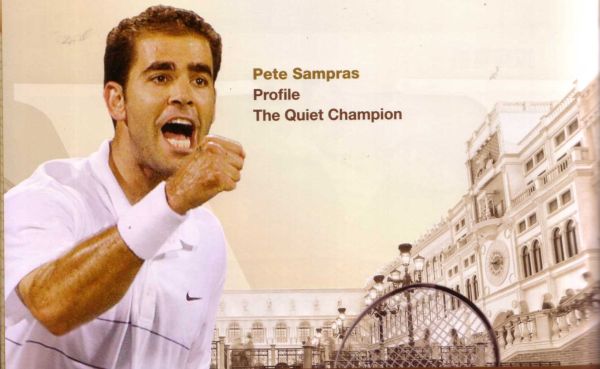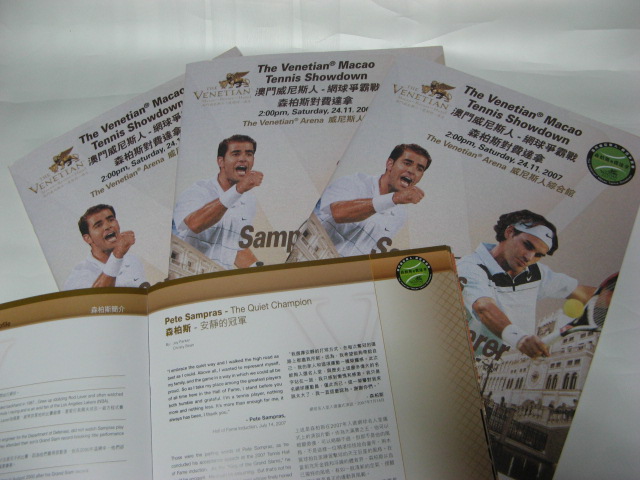
Pete Sampras - The Quiet Champion
"I embrace the quiet way and I walked the high road as best as I could. Above all, I wanted to represent myself, my family, and the game in a way in which we could all be proud. So as I take my place among the greatest players of all time here in the Hall of Fame, I stand before you both humble and grateful. I'm a tennis player, nothing more and nothing less. It's more than enough for me, it always has been, I thank you,"
— Pete Sampras, Hall of Fame Induction, July 14, 2007
Those were the parting words of Pete Sampras, as he concluded his acceptance speech at the 2007 Tennis Hall of Fame induction. As the King of The Grand Slams, he could be arrogant. He could be assuming. But that’s not his style. It’s never been the way of the man whose finely honed skills began in the basement of his childhood home, where he practiced hitting balls with a wooden tennis racket that he found. In a world of overpaid, indulgent athletes, Pete stands out as a class act; a refreshing reminder of what a true sportsman should be.
To watch Pete play, one would think that tennis is an effortless sport. He moves so fluidly around the court, serving up aces and backhanding balls just within the baselines with such finesse that it’s like watching poetry in motion. In truth, it’s a very demanding sport for him. Pete’s single-mindedness about being a pro and achieving the top honors has been the driving force behind his success. However, the road to the top hasn’t always been easy. Illness, injury and devastating tragedies plagued Pete for over a decade. With a show of indomitable spirit, Pete battled back from these challenges time and time again to defeat some of his greatest opponents.
Throughout the years, Pete had many coaches. Each one, in some way, helped improve his game, but three men stand out as being instrumental in helping Pete finesse his skills: Dr. Peter Fischer, Tim Gullikson, and Paul Annacone.
Dr. Peter Fischer taught Pete about the history of tennis, by showing
him movies of many of the great tennis players from the past. Fischer took
a kid known as “Smilin’ Pete” because of his easygoing ways on the court,
and turned him into a formidable opponent and, eventually, a champion. Pete
was originally a baseline player, a fairly safe way to play the game, but
Fischer taught him how to serve the ball and then approach the net (called
“serve and volley”) to defeat his opponent, a more challenging style of
play. By the age of 11, Pete had learned this serve and volley style.
At the age of 16, Fischer suggested that Pete change his backhand stroke
to a one-handed backhand. Since the prevailing backhand style was two-handed,
this did not make Pete very happy, but he agreed to do it. Although Pete
was already a top player for his age, Fischer felt this would help elevate
his game even higher. It was during his time with Fischer that Pete refined
his powerful serve. Fischer taught Pete how to conceal his intentions with
the serve by having Pete toss the ball and Fischer would call out flat or
topspin. By doing this Pete learned how to serve down the T (center of the
serve zone) or serve wide, using the same serving motion. Throughout the
years, this has helped Pete, because his opponents could not read his serve.
At the age of 18, Pete ended his 9-year relationship with Pete Fischer due
to an argument with Sampras’ family over coaching compensation and goal
setting. To this day, though, Pete still credits Dr. Fischer for his early
successes.
In 1989 Tim Gullikson became Pete’s coach. Gullikson was not only a coach to Pete; he was like family. Yes, Pete had learned all the skills to be a good tennis player, but Tim helped to hone his skills. He taught him how to play against left-handed opponents. He also taught Pete how to focus and build points one shot at a time. It was Tim who taught him how to play on grass, a surface with which Pete, initially, wasn’t too thrilled. He taught Pete how to focus on his games and, most importantly, helped him to mature. Imagine being on tour alone with just a coach and a trainer, and being only 18 years old. Pete really needed someone to feel close to; someone to help him with things that family would usually do. When Tim was diagnosed with brain cancer during the 1995 Australian Open, it took a tremendous toll on Pete. Watching his coach, who by that time had become a close friend, fight and lose the battle with cancer was a terrible ordeal for Pete.
In 1996, after Tim died, Paul Annacone became Pete’s coach. One might ask, what could Paul teach Pete? Paul did not feel that Pete used his athletic talent as much as he should. He felt that Pete was so athletic and that he volleyed so well, that it was wrong for him to not to play the net more. Eventually Pete began to come to the net more often. Sampras liked things to be simple, not make big deals out of things. Paul understood this and therein lay the key between Pete and Paul…. communication. Coaching is more that just teaching a player how to play; it’s making suggestions before a match, scheduling tournaments so your player will play at the top of his game at the right times. Coaches handle lost passports, missing luggage, and anything that comes up. Paul took care of all these extraneous things so that Pete could concentrate on becoming a better player. During Paul's run with Pete, Pete won seven Grand Slams and four Master Series championships. Paul coached Pete for six years before leaving to direct United States Tennis Association’s player’s development operations.
Pete is the son of Greek Immigrants, Sam and Georgia Sampras. He has one brother Gus, and two sisters, Stella and Marion. Stella is the tennis coach at UCLA. During Pete’s years in tennis, his family was not there to watch him. His dad would take him to his lesson or to a tournament and the last thing Pete saw was his father walking away. It made him nervous to watch Pete play, so he would leave. The first time Sam and Georgia watched Pete play was during his match with Stefan Edberg in the 1992 U.S. Open final. Pete lost. After that, they stayed away, in superstition. During one of the U.S. Open finals his dad was at a shopping mall and Pete’s match was on television. Sam could not watch the outcome because he was so nervous. In fact, the Sampras’ never came to watch their son play tennis until Wimbledon 2000, when Pete played Patrick Rafter.
Wimbledon 2000 was really special for Pete. As the sun set on Centre Court, where there were no lights, Pete and Rafter slugged it out in what turned out to be a grueling four set match. Fighting tendonitis in his shins, unable to practice beforehand, and the drama of approaching darkness, Pete won the final point and the match, surpassing Roy Emerson’s record of 12 Grand Slams. That should have been special enough, but Pete wanted his parents there and had asked them to come. They did, but did not want to sit in the player’s box, so they sat way up where no one could see them. Even Pete had to ask, “Where are my parents?” After winning, Pete climbed up into the seats, found his dad and mom and hugged them. You could just feel the love between them as they wiped their tears and told Pete that they loved him. Meanwhile, actress Bridgette Wilson, Pete’s fiancée, sat in the player’s box taking pictures and wiping tears from her eyes.
Then came Pete’s final Grand Slam, the 2002 U.S. Open against his contemporary and nemesis, Andre Agassi. Pete hadn’t won anything in two years, but something magical happened and the old Pete was back serving aces, and hitting wonderful returns. Pete ended up defeating Agassi to win his 14th Grand Slam. He then climbed into the stands and went to his wife, Bridgette, who was expecting their first child. They hugged each other and gave each other these wonderful smiles. It was later that he would give Bridgette credit for standing by him, when many others were telling him to retire and saying he was a half-step slower. Pete did retire, on his own terms, at the 2003 U.S. Open.
On Saturday, July 14th Pete was inducted into the Tennis Hall of Fame in Newport, Rhode Island. It was a very warm day and one kept waiting for Pete to do his little swipe of his forehead with his finger, as he often did on the tennis court. Pete’s emotional speech was interrupted many times by tears as he spoke about his coaches, his family and his fans. Looking around the court, there were many in attendance also moved by his speech.
On Sunday, he and Todd Martin played an exhibition match where much joking went on between the two. At one point, Pete broke a string in his racquet and there were no others to play with, so he used a racquet used by Rod Laver in a doubles match earlier that day. It was a wood racquet and Pete played with it for a couple of points. At the end of the match they auctioned off both racquets for a sum of $55,000.
Today, Bridgette and Pete have two sons, Christian, who is 4 years old, and Ryan, who is 2 years old. For the last four years, Pete has been able to be at home with his family, helping Bridgette with the boys and just enjoying playing with them. He’s also been able to be around his parents and siblings, something he couldn’t do much of during his years on the pro tour.
Above article was published in the "Venetian Macao Tennis Showdown" Souvenir Book during the Pete Sampras - Roger Federer tennis exhibition.
